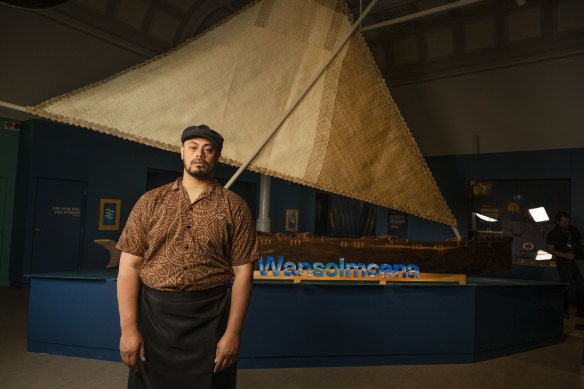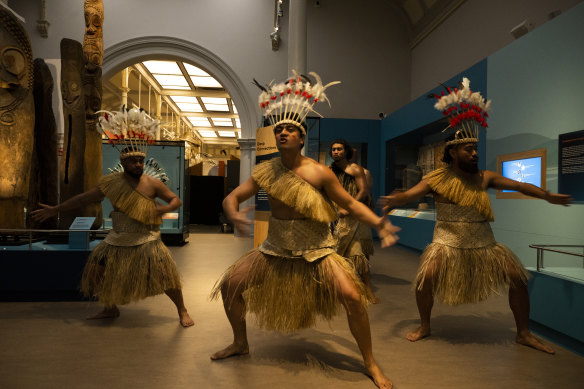‘Don’t forget us’: Why this canoe is a sinking Pacific island’s last hope
By Laura Chung
When Taofia Pelesasa visited the small Pacific island of Tokelau, where his mother grew up, he had a list of places to go. One of the locations was the beach near where she’d gone to school on the tiny island of Tokelau.
But rising sea levels had eaten away at the beach. That’s not all that’s changed due to climate change: the fishing cycles have altered around the island, and sea walls are constantly needed to keep the ocean out.

Taofia Pelesasa hopes this canoe, made by the Tokelauan diaspora in Sydney, will help preserve their culture.Credit: Louise Kennerley
Pelesasa fears that within his lifetime, his island, its culture and history will all be swallowed by the sea.
Tokelau, a dependent territory of New Zealand, is one of a number of low-lying Pacific islands seriously threatened by climate change, which is fuelled by the burning of fossil fuels.
But a new exhibition at the Australian Museum in Sydney, called Wansolmoana, or One Salt Ocean, hopes to commemorate the culture, origins, ancestors, colonisation and the threats of climate change to the Pacific Islands.
Part of the collection, of which Pelesasa is a co-curator, will feature a Tokelauan canoe that was made by the island’s diaspora in Sydney.
The canoe was also part of 200 boats that sailed an anti-coal flotilla in Newcastle harbour in 2014, aiming to hamper shipping.
The museum’s collection will be one of the largest in the world, with artefacts from 54 Pacific communities, including a Fijian warlord’s ceremonial attire and intricate traditional Tongan pole lashings.
“We are saying, not only to the world but the rest of Pacific, ‘don’t forget us’,” he said. “It’s not just sharing our culture, it’s a call to arms for the community to do what they can to prevent something we know is inevitable.”
And although there has been historical tension between museums and how they had collected artefacts, he said much of his community was grateful to have their culture preserved at the Australian Museum.

The new display at the Australian Museum will commemorate Pacific islands, their people and history. Credit: Louise Kennerley
“These spaces are holding on to things for us while we deal with what is in front of us. I am very, very proud to leave a Tokelaun footprint in that space,” Pelesasa said.
“I also think of my young nephews and nieces, and know that if they ever get a bit lost and things seem confusing about where they belong, they will always have a space to go and remember themselves.”
Exhibition lead curator and manager of Pasifika collections and engagement Melissa Malu, a proud Fijian and Tongan woman, said putting the exhibition together had been special.
“It has been very moving to contribute to rekindling and revitalising those practices so they aren’t forgotten. And so that they are kept here in the museum and with all the actual artefacts [that] remind us how talented, gifted and resourceful our ancestors were to thrive and survive,” she said.
Australian Museum director Kim McKay said she hoped to give audiences the chance to experience the creativity and cultural diversity encountered in different parts of the Pacific, as well as share in the culture and stories, as told by First Nations people.
Get to the heart of what’s happening with climate change and the environment. Sign up for our fortnightly Environment newsletter.